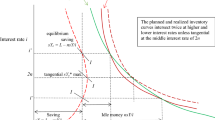Abstract
This paper deals with the stability properties of a closed market, where capital and labour force are acting like a predator–prey system in population-dynamics. The spatial movement of the capital and labour force are taken into account by cross-diffusion effect. First, we are showing two possible ways for modeling this system in only one country’s market (applying a simple functional response and a Holling-type ratio-dependent response as well), examining the conditions of their stability properties. We extend the ratio-dependent model into two countries common market where two kind of cross-diffusion effects are present, and find those additional conditions, whose are necessary for the stability of the global common market besides the stability of each countries local market. Our four-dimensional model highlights that a hectic movement of the capital toward labour force can cause a Turing instability.






Similar content being viewed by others
References
Goodvin, R.M.: A growth cycle. In: Feinstein, C.H. (ed.) Socialism, Capitalism and Economic Growth. Cambridge University Press, Cambridge (1967)
Farkas, M., Kotsis, M.: Predator–Prey and Wage-Employment Dynamics, Dynamic Economic Models and Optimal Control, pp. 513–526. North-Holland, Amsterdam (1992)
Aly, S.: Spatial inhomogenity due to Turing instability in a capital–labour market. Appl. Math. 3, 172–176 (2012)
Farkas, M.: On the distribution of capital and labour in a closed economy. SEA Bull. Math. 19(2), 27–36 (1995)
Farkas, M.: Two ways of modelling cross-diffusion. Nonlinear Anal. Theory Methods Appl. 30(2), 1225–1233 (1997)
Jeffries, C., Klee, V., van den Driessche, P.: Qualitative stability of linear systems. Linear. Algebra Appl. 87, 1–48 (1987)
Farkas, M.: Dynamical Models in Biology. Academic Press, New York (2001)
Casten, R.G., Holland, C.J.: Stability properties of solutions to systems of reaction–diffusion equations. SIAM J. Appl. Math. 33, 353–364 (1977)
Smoller, J.: Shock Waves and Reaction–Diffusion Equations. Springer, Berlin (1983)
Turing, A.M.: The chemical basis of morphogenesis. Philos. Trans. R. Soc. Lond. B 641, 37–72 (1952)
Akcakaya, H.R., Arditi, R., Ginzburg, L.R.: Ratio-dependent prediction: an abstraction that works. Ecology 76, 995–1004 (1995)
Aly, S., Kim, I., Sheen, D.: Turing instability for a ratio-dependent predator–prey model with diffusion. Appl. Math. Comput. 217, 7265–7281 (2011)
Arditi, R., Berryman, A.A.: The biological paradox. Trends Ecol. Evol. 6, 32 (1991)
Ariditi, R., Grinzburg, L.R.: Coupling in predator–prey dynamics: ratio-dependence. J. Theor. Biol. 139, 311–326 (1989)
Cosner, C., DeAngelis, D.L., Ault, J.S., Olson, D.B.: Effects of spatial grouping on the functional response of predators. Theor. Popul. Biol. 56(1), 65–75 (1999)
Kiss, K., Kovács, S.: Qualitative behaviour of \(n\)-dimensional ratio-dependent predator–prey systems. Appl. Math. Comput. 199(2), 535–546 (2008)
Duque, C., Kiss, K., Lizana, M.: On the dynamics of an \(n\)-dimensional ratio-dependent predator–prey system with diffusion. Appl. Math. Comput. 208(1), 98–105 (2009)
Aly, S., Farkas, M.: Bifurcations in a predator–prey model in a patchy environment with diffusion. Nonlinear Anal.: Real World Appl. 5, 519–526 (2004)
Aly, S., Farkas, M.: Competition in patchy environment with cross diffusion. Nonlinear Anal.: Real World Appl. 5, 589–595 (2004)
Author information
Authors and Affiliations
Corresponding author
Rights and permissions
About this article
Cite this article
Balázsi, L., Kiss, K. Cross-Diffusion Modeling in Macroeconomics. Differ Equ Dyn Syst 23, 147–166 (2015). https://doi.org/10.1007/s12591-014-0224-8
Published:
Issue Date:
DOI: https://doi.org/10.1007/s12591-014-0224-8




